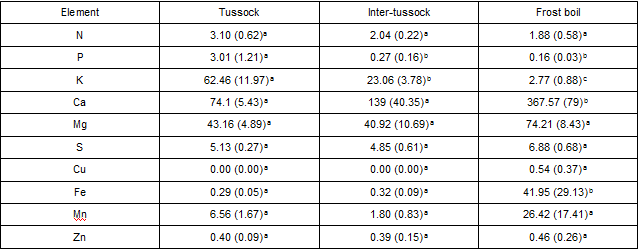Research Applications
Polar regions are expected to experience dramatic effects from global climate change. The magnitude of change is uncertain, but current trends show increased soil temperature, acceleration of nutrient turnover, and changes in plant community composition.
Sullivan and Sveinbjörnsson (2010) used PRS® Probes in tussock tundra to measure macro and micronutrients between tussocks, inter-tussocks, and frost boils. They investigated whether white spruce established in tussocks, inter-tussocks, or frost boils disproportionately to habitat availability. Tussocks had higher N, P, and K, but frost boils had higher Ca, Mg, S, Cu, Fe, Mn, and Zn. White spruce seedlings grew in tussocks (48%) and frost boils (8%) disproportionately to availability of tussocks (22%) and frost boils (2%). This may have been a result of both warmer soil temperatures and higher nutrient availability in the tussocks and frost boils.
Nutrient supply rates (μg cm-2 82 days-1) between June 7 and August 28, 2008 in tussocks, inter-tussocks, and frost boils within the treeline.

Standard errors appear within parentheses and different superscript letters indicate significant differences within elements across habitat types.
Examples
- Tolerance of an expanding subarctic bush, Betula glandulosa, to simulated caribou browsing
- Growing season length and soil moisture interactively constrain high elevation aboveground net primary production
- Effects of simulated grazing in ungrazed wet sedge tundra in the high Arctic
- Taller and larger: Shifts in Arctic tundra leaf traits after 16 years of experimental warming
- Evidence of nonlinearity in the response of net ecosystem CO2 exchange to increasing levels of winter snow depth in the high Arctic of Northwest Greenland
- Nitrogen-dependent recovery of subarctic tundra vegetation after simulation of extreme winter warming damage to Empetrum hermaphroditum
- High Arctic plant community resists 15 years of experimental warming
- Small-scale spatial patterns in N2-fixation and nutrient availability in an arctic hummock hollow ecosystem
- Effects of nitrogen fertilization on plant communities of nonsorted circles in moist nonarctic tundra, Northern Alaska
- Relative impacts of disturbance and temperature: persistent changes in microenvironment and vegetation in retrogressive thaw slumps
- Nutrient status in alpine soils of the Colorado Front Range using the nitrogen/phosphorus ration index
